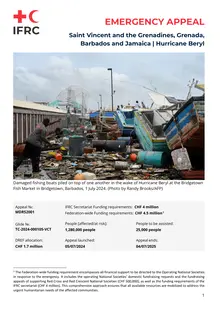SITUATION OVERVIEW
On 25 June, the National Hurricane Centre began monitoring a tropical wave with the potential for development that was moving westward. By 28 June, already transformed into Tropical Depression 2 (system AL95), it began to intensify due to atmospheric conditions and officially became Tropical Storm Beryl.
The final conditions for it to become a hurricane occurred on 29 June, making it the first major hurricane of the 2024 Atlantic hurricane season and the earliest Category 4 hurricane to form in recorded history, on 30 June. By 1 July, it became a Category 5 hurricane with maximum sustained winds of 270 km/h. It is important to remark that Beryl is only the second storm and first hurricane of the season. NOAA forecast predicts an 85% chance of an above-normal season, exceptionally active, with a range of 17 to 25 total named storms. Of those, 8 to 13 are forecast to become hurricanes (winds of 74 mph or higher), including 4 to 7 major hurricanes (category 3, 4 or 5; with winds of 111 mph or higher).
This forecast, plus El Niño phenomenon and the climate change increases the risk of stronger storms and puts the Caribbean in high risk. There is a stronger link to climate change driving larger storms and faster intensification, which means more damage and less preparedness time for National Societies.
According to the forecasts, it is likely that before this response is finished, the same countries affected by Beryl will have to respond to other climate-exacerbated shocks and stresses. These will arrive on people already put in more vulnerable positions by this event.



